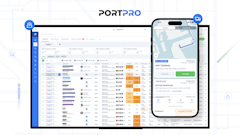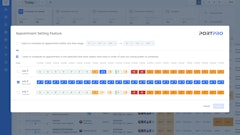
Managing today’s transportation department can be challenging. Many companies do not have a system in place to oversee shipments as efficiently and cost-effectively as possible. They’re riddled with uncertainties, wondering if they are missing out on hidden cost-saving opportunities.
Food Logistics talked to three food manufacturers who chose an on-demand Transportation Management System (TMS) solution to help them manage and control their transportation costs. Each uses a different on-demand TMS vendor.
We discover their reasons for choosing the systems they did, examine their initial goals and examine the subsequent benefits their systems are delivering.
JEL SERT AUTOMATES, CONSOLIDATES
The only way Jel Sert knew it had an incoming order was from the noise of the printer printing the order, says Michael Martinez, director of distribution for The Jel Sert Co. based in West Chicago, IL. “We were totally manual-based. We simply tore the order from the printer, handed it to a carrier, placed the order in the accomplished file, and then moved on to the next order.”
The company began to search for a TMS solution about three years ago. The high-volume shipper ships about 80 percent of its annual volume of 20,000 orders April through July. “So we were really struggling and we needed to find a system that would automate this process for us,” Martinez says. The second goal was to capture opportunities to reduce its freight costs significantly by consolidating shipments.
Martinez chose On-Demand TMS provided by Holland, MI-based LeanLogistics Inc.
“I will admit our worst-case scenario was that we would automate our system even if our freight costs remained the same. Well, the salesman was right and we achieved double-digit percentage savings in our freight costs two years running and ROI was under a year,” says Martinez. “This is critical, especially in this economic environment when capital funds are slow to come by and many companies are not investing. This was definitely a solid investment for us.”
The TMS solution provides a range of functionality such as real-time financial metrics and visibility, helping executives make smarter decisions. The WebSettle module audits and pays invoices to carriers, eliminating the need for the third party Jel Sert had used. “We are paying our carriers quicker now at a lower cost, while removing the error factor we sometimes had with our third-party company,” reports Martinez.
The automated communication between Jel Sert and its carriers, through real-time exception alerts called Advisors, triggers an email alert to Jel Sert advising when something happens—such as a delayed load. The system also is carrier-friendly, as about three-quarters of Jel Sert’s network of 80 carriers were already using this TMS solution. “We have real-time reporting functionality that lets us monitor if we are following our core carrier philosophy of giving the bulk of our volume to about 15 carriers,” Martinez says.
Even with double-digit growth Jel Sert is experiencing, it has not had to increase personnel. “Lean’s TMS solution allows us to be more efficient in our transactions, even with the same head count,” Martinez reports.
The TMS interfaces with Jel Sert’s ERP and WMS solutions. “What attracted us to Lean is their strength in IT and their understanding of interfaces,” explains Martinez. “We can share real-time information with our other two systems, and the real-time communication really helps in proactive decision-making.”
PARIS FOODS CENTRALIZES CONTROL
C.O. Johnson felt his company had a good handle on its core group of carriers who delivered on-time shipments and quality both in service and equipment.
“But I didn’t feel we were getting the best rates we knew were out there because our old system was lacking efficiencies as it was not centrally controlled,” says Johnson, president of Paris Foods Corp., which is headquartered in Trappe, MD.
For instance, it was getting tedious to shop different freight runs individually to the company’s network of approved carriers. “Even with the assistance of electronic communications, we were still sending out multiple requests to multiple carriers to try to obtain the best rates we could,” Johnson explains.
In September 2008, Johnson chose Chicago-based Real Time Freight’s On-Demand Freight Management System. “This is the first solution I saw that is simple to use, and it’s inexpensive and Web-based.”
Johnson notes that the nature of truck logistics is such that at any given time there is a piece of equipment somewhere in the country that wants to go to a particular destination. Finding that piece of equipment equates to found savings.
“The old way of doing things meant calling your usual contacts,” explains Johnson. “You would likely settle on the guy who, although he didn’t have the equipment handy, could run one 200 miles from you. He would pick up your load and get it to your customers on time, but there would be a lot of lost efficiencies,” explains Johnson.
The Real Time solution has opened up those opportunities for better rates and increased efficiencies, reports Johnson. “Our shipments are broadcast out to our approved network of carriers and we can identify an approved carrier with equipment where we need it, so we can get a better rate.”
Online postings have been around for years, especially at truck stops, explains Johnson. “But I don’t have the time to research whether a trucking company is a viable carrier who can be trusted or who has the proper insurance. So this system offers me the postings of my pre-approved corporate carriers and I am confident that when my loads go out, the only eyes looking at those loads are those carriers I am comfortable dealing with,” he says. “It is really a liability factor; I can’t afford to put my company in the position of dealing with an unreliable carrier.”
Real Time’s software takes into consideration a load’s location, where it needs to go, and the characteristics of the load such as whether it’s a load of cases, totes, or pallets. “The system posts temperature requirements, release numbers, and PO numbers for pickup and delivery,” explains Johnson. “When the initial instructions are recorded in the system, the information does not have to be retyped, re-faxed, or verbally told to someone. The driver can just run with the instructions.”
Johnson adds that the on-demand TMS solution brings a level of professionalism to the trucking industry that had been beholden to the old-boy network. “It was all about who you knew. Now there is documentation on everything, including rate confirmation in writing so there is no confusion as to who said what about rates.”
CHIQUITA EXPRESS COLLABORATES
Once Chiquita Brands International purchased Fresh Express, the company found itself using four different ERP systems and two different TMS solutions.
“We wanted to combine our transportation network and realized it would be easier for us to identify one TMS vendor who could create visibility across all four of those ERP networks,” reports Tom Shepherd, vice president of transportation for Cincinnati-based Chiquita Express. “We also wanted to be able to see what loads we had in our network so we could optimize the network in terms of reducing costs, increasing routing efficiencies, and improving customer service.”
Since Chiquita already had a working relationship with Lean Logistics, the company decided to implement Lean’s On-Demand TMS solution. Once go-live preparations were completed, Chiquita transitions to the new TMS over a four-week period beginning in May 2008. “It was one of the most successful implementations we ever had,” says Shepherd. “There was a lot of effort, focus, and cross-functional coordination among ourselves and Lean—as well as internally within the Chiquita organization to be able to pull that off.”
One of the goals was to create an execution platform for all transportation orders within the entire Chiquita network. In addition to interfacing with the four ERP systems, Shepherd wanted to create total network visibility.
“We also wanted to create a tool that would enable visibility to overall performance reporting whether operational or financial. So whether we were shipping bananas, salads, or raw products for our salad business, we wanted to be able to identify our financial and performance reporting metrics and focus all of that through one solution,” says Shephard.
Having all data funneled into one central location helps assess carriers’ transportation performance. “We can keep track of our costs for a particular carrier throughout our network, opposed to working under a fragmented approach,” Shepherd explains. What used to be a time-consuming effort to figure out the company’s on-time performance delivering particular products is now available immediately at one source. This equips the company’s sales force with important data when they visit customers.
Recognizing the potential in collaborating with other shippers as a means to decrease transportation costs, Chiquita is actively working with a select group of companies to expand these opportunities. “From an efficiency standpoint and from an environmental perspective, the more we can look to collaborate and work with other shippers, linking their networks with ours to identify efficiencies, the more we can benefit our operational optimization as well as those of other shippers and the carriers,” explains Shepherd.
Chiquita leveraged the value of its single TMS and now contracts with CASS Information Systems to automate the payment process for all carriers throughout the network, eliminating the need for invoicing. Shepherd reports that the company definitely exceeded its payback expectations.
“These are challenging economic times for everyone. The efficiencies we’ve gained by having full network visibility for all of our customer orders have enabled significant routing, communication, and equipment utilization benefits for both Chiquita and our carriers,” says Shepherd.
One further benefit of the new single TMS solution is that it creates a platform to enable Chiquita to assimilate new distribution opportunities.
“As we introduce new products, we wanted to have a TMS that was robust enough to be able to bring these new products beyond our traditional network,” Shepherd says. “This ability could also allow us leverage in the event of an acquisition. So as we grow and seek out new channels, we have the right tool to allow us to respond to the needs of a changing or expanding market. Identifying a single TMS with this capacity was an important part of the overall decision process for us.”







![2023 Top Software Color[vertical]](https://img.foodlogistics.com/files/base/acbm/scn/image/2023/10/2023_TopSoftware_color_vertical_.653a8505cd258.png?auto=format%2Ccompress&bg=fff&fill-color=fff&fit=fill&h=135&pad=5&q=70&w=240)












![Top Tech Logo Vertical [black]](https://img.foodlogistics.com/files/base/acbm/scn/image/2023/09/top_tech_logo_Vertical__black_.650b43c676e81.png?auto=format%2Ccompress&fit=crop&h=135&q=70&w=240)





